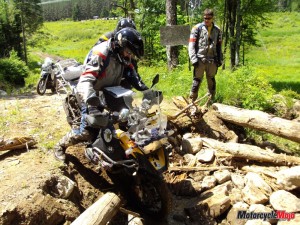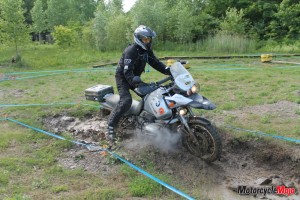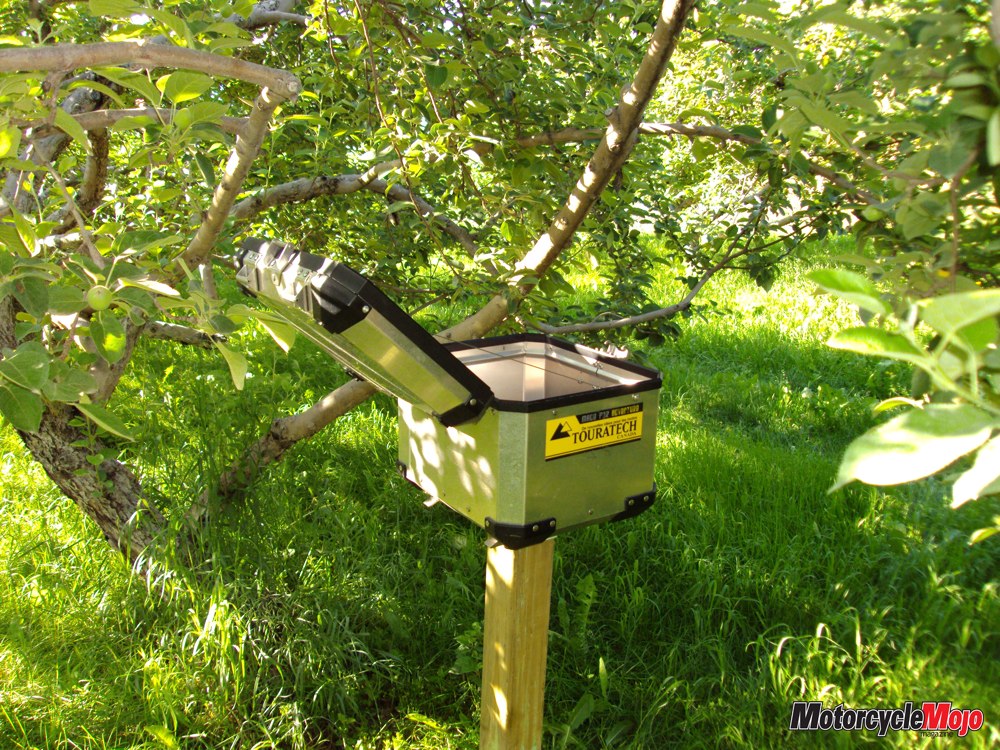A series of difficult challenges, damaged bikes and possibly upset stomachs took place this summer to determine which Canadian riders will represent Canada on the International level.
BMW Motorrad has a unique program giving owners of GS motorcycles a chance to ride in an international off-road rally that the company puts on every two years. Called the GS Trophy, it isn’t an event that caters to jet-set media types or professional, factory-backed racers. It’s meant for average, everyday Joes, albeit with relatively elite off-road riding skills.
The first GS Trophy was held in Tunisia in 2008, and was followed in 2010 by an event held in South Africa that also crossed into Swaziland and Mozambique. I was fortunate enough to have attended that 2010 event as the media representative for Team Canada’s three riders. Nine other teams from 14 nations attended that year. The latest GS Trophy took place in Chile and Argentina last year, and Mojo contributor Lawrence Hacking, a former Paris-Dakar competitor, attended that event as the Canadian media liaison. Fifteen teams from around the world took part in that event. The next GS Trophy is scheduled for 2014, and its location will soon be revealed, though we already know that it will be somewhere in the northern hemisphere.
 GS Trophy participants’ riding skills are assessed at various qualifying events, held throughout the world, that present difficult riding challenges to weed out less capable riders. Having attended a previous Trophy event, I can attest that the challenges are often extreme and very physical, so the elimination process is a critical component of these rallies. Each participating country holds at least one qualifying round, called the GS Challenge, and three such events were scheduled in Canada this year to determine each of the three riders that will represent Team Canada in 2014.
GS Trophy participants’ riding skills are assessed at various qualifying events, held throughout the world, that present difficult riding challenges to weed out less capable riders. Having attended a previous Trophy event, I can attest that the challenges are often extreme and very physical, so the elimination process is a critical component of these rallies. Each participating country holds at least one qualifying round, called the GS Challenge, and three such events were scheduled in Canada this year to determine each of the three riders that will represent Team Canada in 2014.
This year’s first Canadian GS Challenge was held in Montreal and the surrounding area in mid-June, followed a week later by an event held at the Horseshoe Resort in the Barrie, Ontario, area, with the final event taking place in mid-August, based out of 752 West RV-ATV Park in Rocky Mountain House, Alberta.
An invitation came my way to attend the Quebec round of the GS Challenge, hosted by BMW Motorrad Canada and Montreal BMW dealer Moto Internationale. I’d be riding a 2013 F800GS motorcycle provided by BMW Canada.
 The format for this year’s Challenge was different from previous years, as it was based in Montreal instead of somewhere outside the city. A round-trip course was laid out, heading northwest out of the city into the Laurentian Mountains and incorporating a combination of asphalt and gravel roads. Speed was not to be a factor in the rally, and during the Saturday morning briefing we were advised that a radar trap (operated by rally organizers, not the police) would be located somewhere along the route, and participants exceeding the posted speed limit by more than 10 km/h would be docked precious points.
The format for this year’s Challenge was different from previous years, as it was based in Montreal instead of somewhere outside the city. A round-trip course was laid out, heading northwest out of the city into the Laurentian Mountains and incorporating a combination of asphalt and gravel roads. Speed was not to be a factor in the rally, and during the Saturday morning briefing we were advised that a radar trap (operated by rally organizers, not the police) would be located somewhere along the route, and participants exceeding the posted speed limit by more than 10 km/h would be docked precious points.
Along the route were several stations where special tests were performed, some of which established participants’ determination to win (like the first stop, which included eating dried caterpillars), and some putting riding skills to the test. This rally assessed skills, team co-operation, camaraderie and navigational abilities.
A road book was handed out on Saturday morning with route directions and instructions, as well as a logbook to be filled out and certified by rally monitors along the way. It was each competitor’s scorebook, and we were told to hang onto it as if it were a passport – losing it would mean the end of your rally. One competitor, who took the GS Challenge seriously enough to buy a used F650GS just to compete in it, unfortunately lost his logbook and had to forfeit the rally, though he courageously continued with each challenge and completed the course nonetheless.
There were two special guests onboard who would act as judges in the final Trophy challenge on Sunday, which placed the top six riders from Saturday’s ride against each other in an extreme test of off-road riding skills. Seven-time Dakar finisher Australia’s Simon Pavey, as well as three-time Dakar competitor Tina Meier from Germany, would keep a watchful eye on the competition, scoring each rider and determining who would be part of the 2014 Trophy event.
We began Saturday morning with a skill-testing math equation before we even left the Moto Internationale parking lot. Riders were asked to calculate (or count) the number of bricks on a wall before being allowed to ride off. I guess everyone eventually figured it out, as I was the last to depart after teaming up with BMW Canada’s Norm Wells (I can count, but being a media guest I wasn’t eligible to compete, so I didn’t have to provide an answer).
About a half-hour into the rally was the first stop, where riders cheerfully and nauseatingly swallowed a tablespoonful of dried caterpillars. I was very grateful to be a member of the non-competing media at this point.
From there, we continued on pavement to other brain-teasing challenges, like finding a top case in an apple orchard to retrieve the stamp inside, then heading to a random intersection where we were asked to find something that seemed out of place. It turned out to be a couple of soft drink machines in the woods. There was also a serial number to retrieve, which was attached to an oak tree by a river and hidden from view (competitors had to wade in a couple of feet of water to find that one, which explained why organizers had earlier suggested bringing a swimsuit).
One final physical challenge was a 400-metre trek in a kayak to retrieve another stamp hidden in a box by the shore of a small island. It was after the kayak station that we finally hit the dirt.
We turned north onto Scotch Road off Highway 148 in Grenville, Quebec. The first portion of Scotch Road had been widened, divided and paved a couple of years ago, up to the point where it meets Autoroute 50, after which it narrows into a single-lane road and eventually turns into a gravel trail.
Standing on the foot pegs, I guided the GS along this winding, rocky and undulating trail, but not before stopping to switch off the ABS and traction control. The traction control can be switched off and on while riding, but shutting off the ABS requires that the ignition be turned off and on again. Forgetting to switch off these electronic interventions when on dirt causes the GS to burble and stumble, quite frustratingly, when rolling on the gas in a turn or going uphill, and stopping distances become considerably longer.
After about a dozen kilometres, we arrived at the first riding challenge station, a bowl-shaped sandpit with steep sides. Riders had to negotiate a small course laid out along the sides of the sandpit walls, including a steep ascent and descent. They had to do three laps of this circuit within five minutes, preferably without touching the ground with their feet or dropping their bikes, as either of those would cost them points. It was quite an impressive sight to see the large R1200GSs blast up the steep hill, throwing a massive rooster off their rear tires, and then circling around to do it again. While I was there, only one of the half-dozen contestants achieved this without dropping his machine. As I said, the challenges were difficult, but the worst was yet to come.
More winding gravel roads brought us to the second-last station of the day, aptly called Mount Everest. It was a ferociously steep and rocky climb, but to get to it, riders had to first wade through a mud bog and traverse a bike-swallowing ravine.
Engines bumped on rev limiters, mud flew and undercarriages crashed on jagged rocks – some bikes lost some bits – and then came the climb, which would have been hard enough to negotiate on your feet, let alone on a 500-plus pound machine. All of this was worth 200 points, 100 if riders decided to turn back after the mud bog. Once clear of the steep hill, it was a 15-minute ride through tight trails and two more mud bogs back to the starting point.
From there, we headed back to the headquarters in Montreal using mostly the highway, as everyone was expected by 5 p.m. for a barbecue dinner and an off-road demonstration set up in a field behind the store.
Menacing weather greeted competitors on Sunday morning as the top six riders headed to Ormstown for the final challenge. It was to be a tough, trials-type event designed by Pavey, but when rain began falling by noon, the already waterlogged ground flooded and became unrideable. Organizers cancelled the test and set up an impromptu course back at the field behind Moto Internationale.
The winner of the Montreal round of the GS Challenge is Patrice Glaude, who will join Corey Hanson, winner of the Ontario round, as well as the top Alberta challenger to make up Team Canada in the 2014 GS Trophy. We might not yet know where it will be held, but one thing is absolutely certain: competing riders will be taking part in the experience of a lifetime.



















































